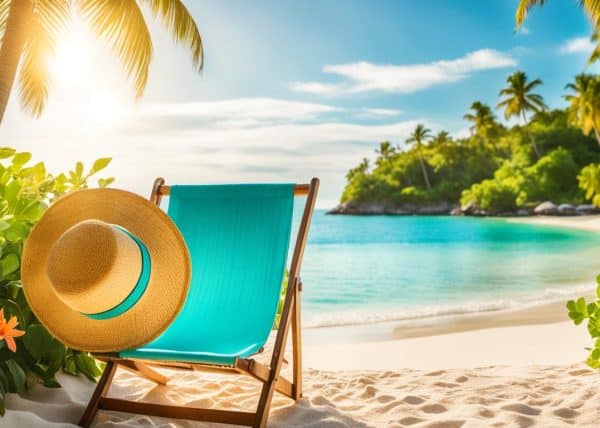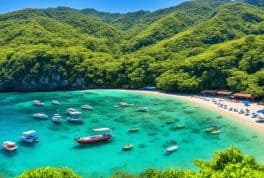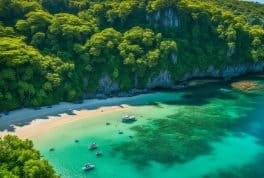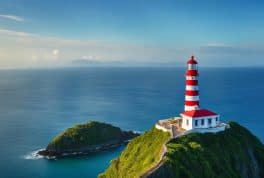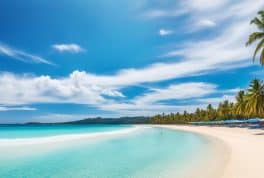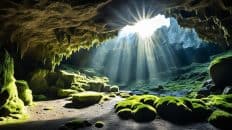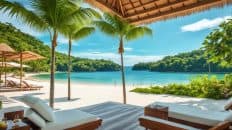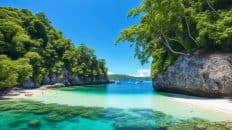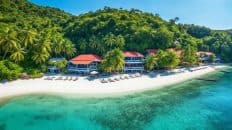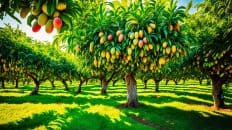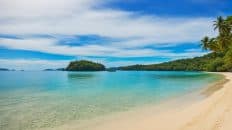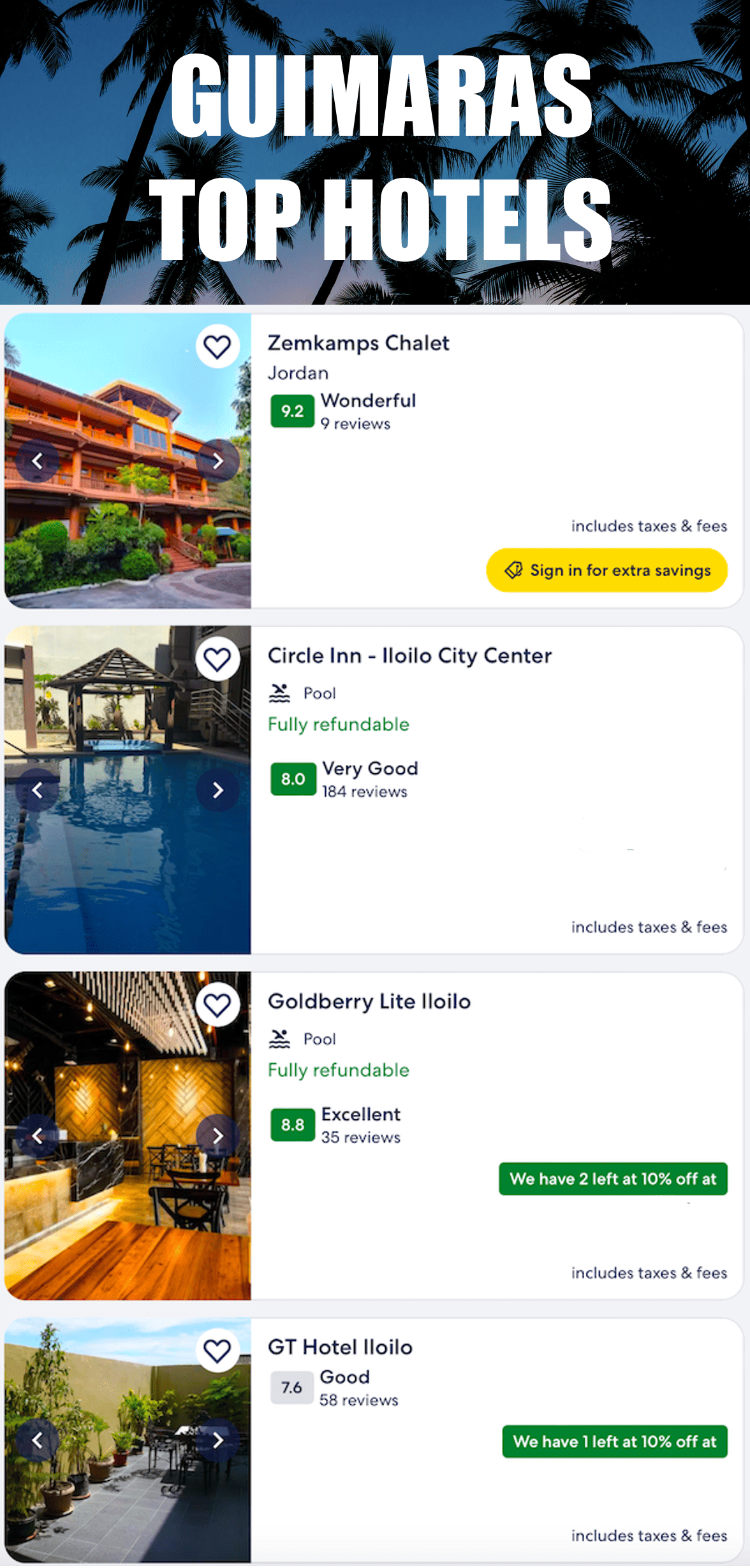Guimaras Island
Guimaras, a serene island in the Philippines, is celebrated for its world-famous sweet mangoes, pristine beaches, and crystal-clear waters. It's a blend of natural beauty, cultural heritage, and eco-friendly initiatives, including notable landmarks like the Trappist Monastery and Guimaras Wind Farm. This charming island offers a tranquil retreat with a warm, welcoming atmosphere, making it an ideal destination for nature enthusiasts and those seeking a peaceful escape.
Top 10 Things to see in Guimaras
Guimaras, an island province in the Philippines, is known for its picturesque landscapes, cultural sites, and unique attractions. Here are the top 10 things to see in Guimaras:
- Mango Plantations: Guimaras is famous for producing some of the sweetest mangoes in the world. Touring a mango plantation allows visitors to see how these celebrated fruits are grown.
- Trappist Monastery: This peaceful monastery is run by monks of the Cistercian Order. It's a place for tranquility and spiritual reflection, and they also produce and sell products like mango jams and religious items.
- Guimaras Windmills: Offering a glimpse of renewable energy in action, the windmills are not only functional but also provide a scenic view against the backdrop of Guimaras' landscapes.
- Alubihod Beach: Known for its white sandy shores and clear waters, Alubihod Beach is perfect for swimming, snorkeling, and enjoying the tropical sun.
- Ave Maria Islet: This small, uninhabited islet is a popular spot for picnics and swimming, with its pristine beach and crystal-clear waters.
- Roca Encantada: Also known as the Enchanted Rock, this is the Lopez family's summer house, built on a huge rock. It offers panoramic views of the sea and is a historical landmark.
- Smallest Plaza: Once recognized by the Guinness Book of World Records as the world's smallest plaza, this site in Guimaras is a quaint and curious attraction.
- Navalas Church: The oldest Roman Catholic church in the province, Navalas Church is a testament to Spanish colonial architecture and Guimaras' rich history.
- Taklong Island National Marine Reserve: Ideal for eco-tourists, this marine reserve boasts of diverse marine life, mangroves, and pristine beaches.
- Balaan Bukid Shrine: A popular destination especially during Holy Week, this site features a large cross and offers a panoramic view of the island and its surroundings.
These attractions make Guimaras a unique and must-visit destination, blending natural beauty with cultural and historical richness.
Guides and Tours

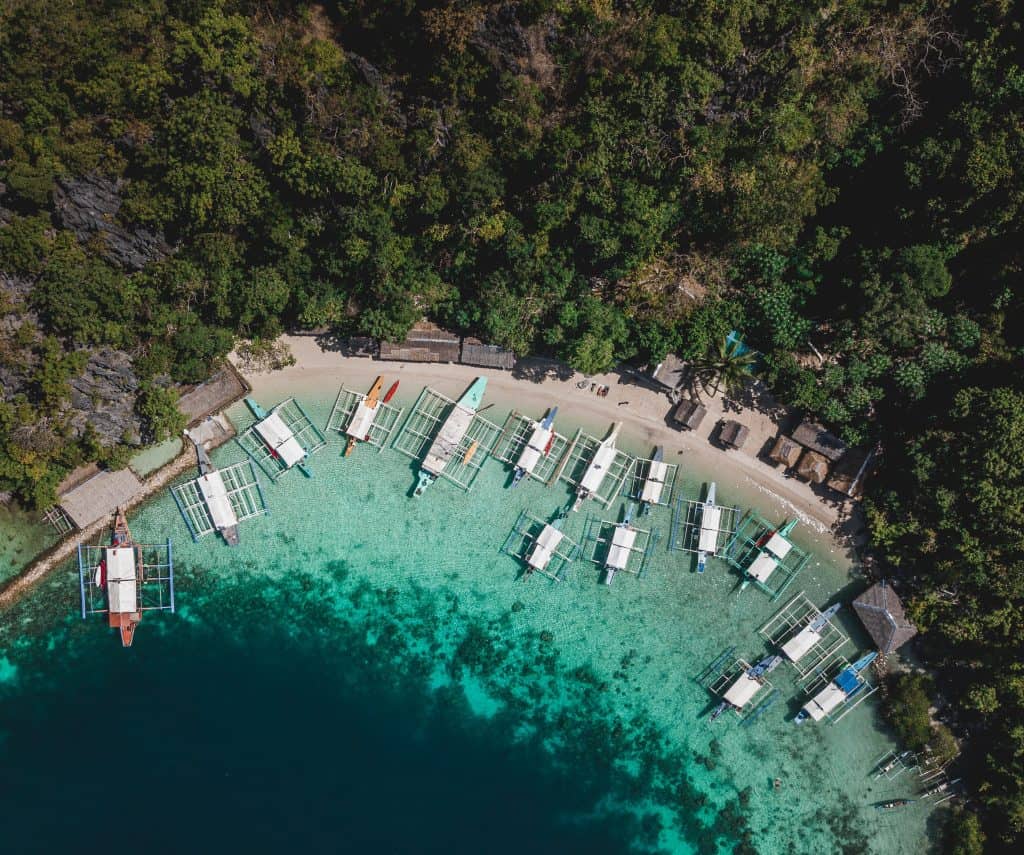
Top 10 Questions and Answers about Guimaras
- What is Guimaras most famous for? Guimaras is renowned for producing some of the sweetest and best-quality mangoes in the world. These mangoes are even served at the White House and Buckingham Palace.
- How do you get to Guimaras? The primary way to reach Guimaras is by boat. From Iloilo City, you can take a short pump boat ride from the Ortiz or Parola wharfs to Jordan or Buenavista in Guimaras.
- What are the best beaches in Guimaras? Alubihod Beach is one of the most famous, known for its clear waters and white sand. Other notable beaches include Guisi Beach, Natago Beach, and Ave Maria Islet.
- Are there any historical landmarks in Guimaras? Yes, notable landmarks include the Trappist Monastery, the Roca Encantada, and the Navalas Church, which is the oldest Catholic church in the province.
- What activities can tourists do in Guimaras? Activities include beach hopping, visiting mango plantations, exploring historical sites, trekking to Balaan Bukid, island hopping, and enjoying local festivals.
- What is the best time to visit Guimaras? The best time is during the dry season from November to May, with the Mango Festival in May being a particularly vibrant time to visit.
- Can visitors tour the mango plantations? Yes, many mango plantations offer tours where visitors can learn about mango cultivation and even taste or buy fresh mangoes.
- Is Guimaras a good destination for eco-tourism? Absolutely, with its natural reserves like the Taklong Island National Marine Reserve and various eco-parks, Guimaras is great for eco-tourism.
- What are the accommodation options in Guimaras? Guimaras offers a range of accommodations, from luxury resorts to budget-friendly guesthouses, especially near popular beaches like Alubihod.
- What are some local delicacies to try in Guimaras? Besides fresh mangoes, visitors should try mango-based products like jams, pies, and dried mangoes. Local seafood and traditional Filipino dishes are also a must-try.
These questions cover a broad range of topics about Guimaras, from travel logistics to local attractions and activities, providing a comprehensive overview for anyone interested in visiting the island.
Why you should visit Guimaras
Visiting Guimaras: An Unforgettable Experience
Nestled in the heart of the Philippines, Guimaras stands as a testament to the country's raw beauty and cultural richness. A visit to Guimaras is more than just a trip; it's an exploration into a world where nature's beauty is in perfect harmony with the warmth of its people and the richness of its culture. This island province, famed for producing the sweetest mangoes in the world, offers an array of experiences that cater to every type of traveler, from the adventure-seekers to the peace-lovers.
The Lure of Guimaras’ Mangoes
The journey into the heart of Guimaras begins with its most famous offering - the mangoes. Known globally for their sweetness and succulent flesh, these mangoes are not just fruits; they're a cultural icon, a source of pride for the locals. Visiting the mango plantations is an experience in itself. Walking through rows of mango trees, learning about the cultivation process, and tasting these sun-kissed fruits is an absolute delight. The mango season, which peaks from April to May, is the best time to visit, coinciding with the annual Manggahan Festival, a celebration of the island's mango harvest.
Guimaras’ Natural Splendors
Beyond its mangoes, Guimaras is a trove of natural wonders. The island's beaches, such as Alubihod Beach, are perfect for those seeking a serene escape. With their white sands and crystal-clear waters, they offer an idyllic setting for sunbathing, swimming, and snorkeling. For the more adventurous, island hopping around Guimaras brings you to hidden coves and unspoiled beaches, each with its unique charm.
The island's interior is equally captivating. The Guimaras landscape, dotted with rolling hills and verdant forests, is ideal for trekking and mountain biking. A hike to the Balaan Bukid Shrine, a religious site atop a hill, rewards visitors with panoramic views of Guimaras and its surroundings, a sight that's especially magical at sunset.
Cultural and Historical Tapestry
Guimaras is not just about natural beauty; it's also a place steeped in history and culture. A visit to the Trappist Monastery offers a glimpse into the spiritual life on the island. This monastery, run by monks of the Cistercian Order, is not only a place of worship but also a hub where visitors can purchase products made by the monks, such as jams and religious items.
Historical landmarks such as the Roca Encantada, the ancestral house of the Lopez Family, and the Navalas Church, the oldest Roman Catholic church in Guimaras, provide insights into the island's rich heritage. These sites are not just structures; they're storytellers, narrating tales of Guimaras’ past.
Guimaras’ Festivals and Local Life
The heart of Guimaras beats in its festivals and the daily lives of its people. The Manggahan Festival, celebrating the island's mango industry, is a burst of color, music, and dance, showcasing the local culture and traditions. The festival is an immersive
experience, with street dances, mango-eating contests, and cultural shows. It's an occasion where the community comes together, and visitors are welcomed as part of the family.
Apart from the Manggahan Festival, Guimaras celebrates other festivals throughout the year, each with its unique flavor and charm. These festivals are a testament to the island's rich cultural tapestry and the locals' love for life.
Guimaras’ Sustainable and Eco-Friendly Initiatives
In recent years, Guimaras has made significant strides in promoting sustainable tourism. The island is home to several eco-friendly resorts and activities that allow visitors to enjoy its natural beauty while minimizing their environmental impact. The Guimaras Wind Farm, an initiative for renewable energy, stands as a symbol of the island's commitment to sustainability.
Eco-tourism activities like visiting the Taklong Island National Marine Reserve, where you can see diverse marine life and mangroves, are educational and inspiring. These initiatives not only enhance the visitor experience but also ensure that the beauty of Guimaras is preserved for future generations.
The Culinary Journey in Guimaras
The culinary experience in Guimaras is as diverse as its landscape. Apart from the world-famous mangoes, the island offers a variety of local dishes that are a must-try. Seafood, freshly caught and cooked in traditional Filipino style, is a staple in the local diet. Restaurants and eateries across the island serve dishes that are a blend of indigenous flavors and influences from various culinary traditions.
Mango-based delicacies like mango pizza, mango pasta, and even mango ketchup are unique to Guimaras and reflect the island's creativity and love for its most famous produce.
Accommodation Options in Guimaras
Guimaras caters to all types of travelers, with accommodation options ranging from luxurious resorts to budget-friendly inns. Whether you're looking for a beachfront villa, a cozy bed and breakfast, or an eco-friendly lodge, Guimaras has something to suit your preferences and budget.
Connecting with the Locals
One of the most enriching aspects of visiting Guimaras is the opportunity to interact with the locals. Known for their hospitality and warmth, the people of Guimaras make every visitor feel at home. Engaging with the locals, whether it's through a conversation at a local market or during a village festival, adds a depth to the travel experience that goes beyond sightseeing.
Conclusion: The Unmissable Charm of Guimaras
In conclusion, Guimaras is a destination that offers more than just picturesque landscapes and delicious mangoes. It's a place where every experience, every interaction, and every sight is imbued with the warmth and spirit of its people and culture. Whether you're seeking adventure, relaxation, cultural immersion, or culinary delights, Guimaras delivers it all with a unique charm and grace. A visit to Guimaras is not just a journey through an island; it's an exploration into the heart of the Philippines at its most genuine and welcoming. This island, with its unspoiled beauty and rich cultural tapestry, is a must-visit for anyone looking to experience the true essence of the Philippines.
Getting to Guimaras
Getting to Guimaras, a picturesque island in the Philippines, involves a few steps, primarily focusing on a journey via Iloilo City, which is the usual gateway to Guimaras. Here's a step-by-step guide:
- Travel to Iloilo City: First, you need to reach Iloilo City. This can be done by:
- Air: If you're coming from outside the Philippines or from a distant region within the country, the most convenient way is to fly to Iloilo International Airport.
- Sea: You can also take a ferry or ship to Iloilo if you are traveling from other islands or regions in the Philippines.
- From Iloilo International Airport to Iloilo City Proper: If you're arriving by air, you’ll land at Iloilo International Airport, which is located outside the city proper. To reach the city, you can take a taxi, van, or airport shuttle. The journey to the city center takes about 30 minutes to an hour, depending on traffic.
- Go to the Parola or Ortiz Wharf: Once in Iloilo City, proceed to either the Parola or Ortiz Wharf. These are the main jump-off points for pump boats going to Guimaras. The choice of wharf may depend on your final destination in Guimaras:
- Ortiz Wharf: This is usually for travelers heading to Jordan, the capital of Guimaras.
- Parola Wharf: This is often used for trips to Buenavista, another major town in Guimaras.
- Take a Pump Boat to Guimaras: From the wharf, you'll take a pump boat (a small, motorized boat) to Guimaras. The boat ride is relatively short, typically about 15 to 20 minutes. These boats operate regularly throughout the day, but it's always good to check the schedule, especially if you're traveling late in the day or during holidays.
- Arrival in Guimaras: Upon arriving in Guimaras, you can hire tricycles, jeepneys, or vans to take you to your specific destination on the island, whether it’s a beach resort, a specific town, or a tourist spot.
- Plan Your Trip: It's advisable to plan your trip in advance, especially during peak seasons like summer and during festivals. Accommodations can be booked in advance, and if you’re planning to visit several sites, you might consider arranging for a tour or a vehicle rental for convenience.
Remember, schedules and availability can vary, especially in light of travel restrictions or changes due to weather conditions. Always check the latest travel advisories and boat schedules close to your departure date.
Top 10 Hotels on Guimaras
Guimaras, an island province in the Philippines known for its pristine beaches and sweet mangoes, offers a variety of accommodations ranging from luxury resorts to more budget-friendly options. Here are the top 10 hotels in Guimaras, each known for their unique features and excellent service:
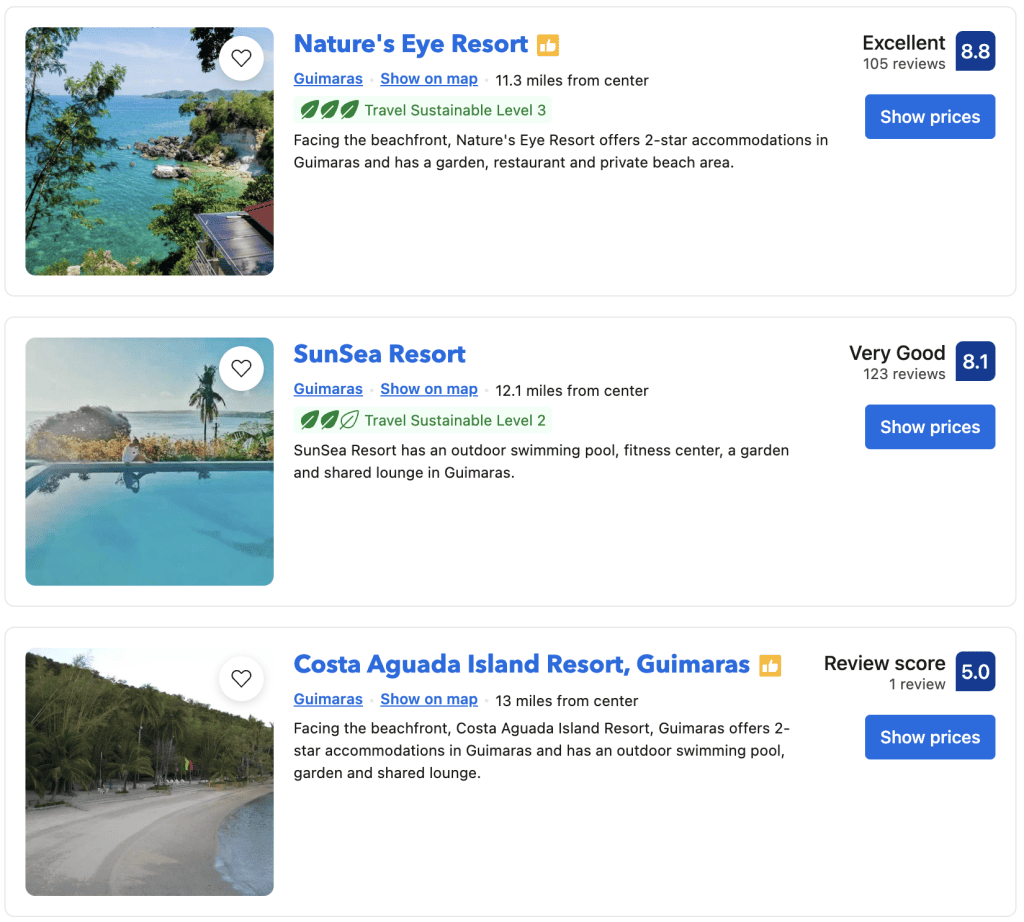
- Raymen Beach Resort - Located in Alubihod Beach, this is one of the most popular resorts in Guimaras. Known for its beautiful beachfront and comfortable accommodations, it's ideal for both families and solo travelers.
- Costa Aguada Island Resort - Situated on Inampulugan Island, this eco-resort offers a unique experience with its jungle setting, wildlife, and pristine beaches, making it perfect for nature lovers.
- Nature's Eye Resort - A more secluded option, this resort is known for its rustic and eco-friendly accommodations, offering a tranquil experience with stunning views of the sea.
- Magic Island Resort - Located in Sibunag, this resort offers a peaceful retreat with comfortable rooms and excellent facilities, including a swimming pool and a restaurant serving local cuisine.
- Camp Alfredo Adventure Resort - Ideal for adventure enthusiasts, this resort offers activities like zip-lining, rappelling, and rock climbing, along with comfortable lodgings.
- Guimaras Mountain Resort - This resort is perfect for those who want to enjoy a mountainous landscape. It offers outdoor activities like hiking and also has facilities for events and conferences.
- Abelard's Beach Resort - A quaint and quiet beachfront property, perfect for those looking for a relaxing stay by the sea.
- Andana Resort Guimaras - A luxury resort offering elegant accommodations, a swimming pool, and a private beach area, making it ideal for a lavish getaway.
- Jannah Glycel Beach House - This cozy beachfront property offers a serene atmosphere and is known for its friendly staff and comfortable rooms.
- Kenyama Beach Resort - Located near the famous Alubihod Beach, this resort is perfect for beach lovers looking for affordable yet comfortable accommodations.
Each of these hotels and resorts offers a unique experience of Guimaras, catering to different preferences, whether you're seeking adventure, relaxation, or a luxurious retreat. It's always advisable to book in advance, especially during peak tourist seasons, to ensure availability
Guimaras Facts
1. Introduction to Guimaras
Nestled in the heart of the Philippines is Guimaras, an enchanting island province that exudes a tranquil yet vibrant atmosphere. This picturesque island, located in the Western Visayas region, is not only famed for its natural beauty but also for its cultural richness, historical significance, and, most notably, its world-renowned mangoes. This introductory section aims to provide a comprehensive overview of Guimaras, highlighting its geographical, historical, and cultural aspects, thus setting the stage for a deeper exploration of this captivating province.
Guimaras is situated located in the Panay Gulf, located between the islands of Panay and Negros. To its northwest lies the province of Negros Occidental, and to the northeast, located across the Iloilo Strait, is Iloilo City. The Guimaras Strait, which serves as a natural boundary between it and the city and rest of its neighboring provinces, not only holds geographical importance but also adds to the island's scenic charm. The island's proximity to these areas makes it an accessible escape for both locals and tourists seeking respite from the bustling city life.
The island province of Guimaras, with its total area of land area encompassing a modest yet vibrant landscape, is a treasure trove of natural wonders. From lush greenery to pristine beaches, the island is a haven for nature lovers. The island's topography is varied, featuring rolling hills, fertile plains, and secluded coves, all contributing to its unique charm. The beaches of Guimaras, known for their crystal-clear waters and fine sand, are a major draw for tourists. The island's coastline is dotted with numerous resorts, ranging from the luxurious Andana Resort Guimaras to the more quaint and serene beach resorts in Guimaras.
Guimaras boasts of a rich and diverse marine ecosystem. The coral reefs surrounding the island are teeming with marine life, making it a perfect spot for snorkeling and diving enthusiasts. The nearby islands, easily accessible by boat, offer a more secluded experience for visitors. Moreover, the seagrass beds around the island play a crucial role in the marine ecology, providing habitat for various marine species and contributing to the island's biodiversity.
One cannot talk about Guimaras without mentioning its most famous export – the Guimaras mango. Dubbed as the sweetest mangoes in the world, Guimaras mangoes have become synonymous with the island, branding it as the "Mango Capital" of the Philippines. These mangoes are so revered that they have their own festival, the Guimaras Manggahan Festival, an annual celebration that showcases the island's rich culture and its love for this succulent fruit.
Historically, Guimaras has been an important location since the Spanish colonial era. It was initially a part of Iloilo province and gained attention due to its strategic location in the Visayas. The Spanish settlement has left an indelible mark on the island’s culture and heritage. Guimaras was also influenced by the Augustinian Order, which played a significant role in the religious and societal structure of the island. This historical backdrop adds a layer of depth to the island's identity, making it a fascinating destination for history buffs.
In terms of governance, the provincial government of Guimaras has been pivotal in shaping the island's development. The island was granted the status of a full-fledged province in the 1990s, a significant milestone that marked its political and administrative independence. This autonomy allowed the local government, led by the governor and the municipal president, to focus on tailored development plans for the province. The full province of guimaras is divided into five municipalities – Jordan, the capital; Buenavista; Nueva Valencia; Sibunag; and San Lorenzo. Each municipality has its unique charm and attractions, contributing to the island's overall allure.
The economy of Guimaras is primarily based on agriculture, with mango production being the cornerstone. However, the island is also known for other agricultural products like coconut milk, cashew nuts, and various other fruits. The agricultural sector is supported by the provincial government, ensuring sustainable practices and growth. In addition to agriculture, tourism has emerged as a vital component of Guimaras' economy. The island's natural beauty, coupled with its rich cultural heritage, makes it an attractive destination for tourists. The development of resorts, such as the beach resort in Jordan Guimaras, has further bolstered the island's tourism sector.
Guimaras is also known for its commitment to environmental preservation. In the wake of the Guimaras oil spill, one of the worst maritime disasters in the Philippines, the island has taken significant steps towards environmental conservation. This tragedy has been a catalyst for change, leading to increased awareness and efforts to protect the island's natural resources.
The charm of Guimaras extends beyond its physical beauty. The island is a melting pot of cultures, reflected in its festivals, cuisine, and everyday life. The locals of Guimaras, known for their warmth and hospitality, add to the island's appeal. Their resilience and community spirit have been instrumental in the island's recovery and growth, especially following challenges such as the oil spill.
In conclusion, Guimaras is more than just an island province in the Philippines; it is a microcosm of the country's natural beauty, rich history, and vibrant culture. Whether it's to indulge in the sweetest mangoes, explore the unspoiled natural landscapes, or immerse in a unique cultural experience, Guimaras beckons with its myriad of attractions. As we delve deeper into the various facets of this enchanting island in the following sections, it becomes evident why Guimaras is not just a destination but an experience to be cherished.
2. Historical Background
Guimaras, a gem in the heart of the Philippines, is an island province rich in history and cultural heritage. This section aims to unravel the historical tapestry of Guimaras, tracing its journey from a once-obscure island to a province with a distinct identity and charm. The island's past is a mosaic of events and influences, from early settlements to colonial impacts, which have collectively shaped its present-day character.
The history of Guimaras is as colorful as its landscapes. The island's story began long before the Spanish explorers set foot on Philippine shores. Initially, Guimaras was inhabited by indigenous communities, living in a society that was rich in tradition and closely connected to the land and sea. These early inhabitants laid the foundation of a culture that would later be influenced by external forces.
The arrival of the Spanish in the Philippines marked a significant turning point in the history of Guimaras. The island became a focal point due to its strategic location in the Guimaras Strait, which was essential for maritime navigation. Spanish influence on Guimaras is evident in various aspects of life, from architecture to religion. The Augustinian Order played a pivotal role in this transformation, introducing Christianity and establishing regular parishes, which led to profound changes in the social and cultural fabric of the island.
Guimaras, during the Spanish era, was administered as part of Iloilo. It was a time when the island started to gain recognition, albeit as a backdrop to the more prominent neighboring areas. Spanish rule lasted for centuries, leaving an indelible mark on the island's culture and heritage. The churches and other historical structures built during this period are not just architectural marvels but also symbols of a bygone era that significantly influenced the island's identity.
The turn of the 20th century brought another shift in Guimaras' history. Following the Spanish-American War, the Philippines, including Guimaras, came under American rule. This period introduced new administrative and educational systems, further shaping the societal structure of the island. However, it was after gaining independence from the United States that Guimaras started to emerge from the shadows of its larger neighbors.
The post-independence era was a time of significant change for Guimaras. The island, which had been a sub-province of Iloilo, embarked on a journey towards self-governance. This quest culminated in the enactment of a Republic Act, which officially declared Guimaras an independent province. This political emancipation in the 1990s marked a new chapter in the island's history, paving the way for self-determination and local governance.
The establishment of the provincial government of Guimaras was a crucial milestone. It gave the islanders a chance to chart their own course, focusing on sustainable development and preserving their unique heritage. The local government, led by the governor, worked towards enhancing the province's infrastructure, promoting tourism, and preserving the cultural and natural assets of the island.
The five municipalities of Guimaras - Jordan, Buenavista, Nueva Valencia, Sibunag, and San Lorenzo - established, each with their distinct characteristics, started to flourish. Jordan, established as the capital, became the administrative and commercial center of the province. Nueva Valencia, with its picturesque landscapes and rich marine life, emerged as a tourist favorite. San Lorenzo, known for its agricultural lands, became a significant contributor to the province's economy.
Throughout its history, Guimaras has faced various challenges, including natural disasters and environmental crises. One such event was the devastating oil spill, which had a significant impact on the island's ecosystem and the livelihood of its residents. This tragedy, however, also showcased the resilience and unity of the Guimarasnons. The community came together, supported by the provincial government and various organizations, to overcome the aftermath and restore the island's natural beauty.
Guimaras' history is not just a tale of political and social changes; it is also a story of cultural evolution. The island's culture, influenced by various external and internal factors, is a rich blend of traditions and modernity. The Guimaras Manggahan Festival is a testament to this cultural vibrancy. This annual event celebrates the island's most famous produce, the Guimaras mango, and is a time for joyous festivities, showcasing local customs, music, and dance.
In conclusion, the historical background of Guimaras is a narrative of transformation and resilience. From its early days as a quiet island to its current status as a thriving province, Guimaras has navigated through various periods - pre-colonial, Spanish, American, and post-independence - each leaving its mark on the island. This rich history is not merely a record of the past; it is a living part of the island's identity, influencing every aspect of life in Guimaras. As we delve into the next sections, the enduring legacy of Guimaras' history continues to be a guiding light, illuminating the path towards a promising future.
3. Geography and Environment
The island province of Guimaras, nestled in the heart of the Philippines, is a geographical marvel that boasts a diverse and vibrant natural environment. This section delves into the topographical and ecological wonders of Guimaras, highlighting its unique landscape, rich biodiversity, and environmental initiatives. The geographical features of Guimaras not only define its physical beauty but also play a crucial role in shaping the lifestyle and culture of its inhabitants.
Geographically, Guimaras is situated in the Western Visayas region, lying between Panay and Negros islands in the Visayas archipelago. It is surrounded by the Guimaras Strait, the Iloilo Strait, and the Panay Gulf, making it a significant maritime location. The island's strategic position at sea level has been influential in its historical and economic development. The total land area of Guimaras is relatively modest, yet it encompasses a range of landscapes, from undulating hills to fertile plains, which contribute to its picturesque beauty.
The topography of Guimaras is characterized by gentle to steep terrain. The central and northern parts of the island are marked by hilly and mountainous areas, while the coastal regions consist of flat to gently sloping lands. This varied topography has resulted in diverse ecosystems and habitats, supporting a wide range of flora and fauna. The island's lush greenery, including mangrove forests and coconut plantations, not only enhances its scenic appeal but also serves as vital ecological zones.
Guimaras is renowned for its pristine beaches, crystal-clear waters, and unspoiled coral reefs. The coral reefs around the island are among its most precious natural assets, hosting a multitude of marine species. These vibrant underwater ecosystems are not only crucial for marine biodiversity but also attract snorkelers and divers, contributing to the island's tourism industry. The seagrass beds, found in the shallower waters, play a significant role in maintaining the ecological balance of nearby islands, providing breeding grounds for various marine organisms.
The environment of Guimaras is also home to several nearby islands, each offering unique experiences and natural attractions. These smaller islands, accessible by boat, are often less crowded, allowing visitors to enjoy a more tranquil and intimate connection with nature. The preservation of these natural habitats is a priority for the provincial government of Guimaras, as they are essential for sustaining the island's ecological health and tourism appeal.
Guimaras is not only about its coastal and marine ecosystems. The island's interior is a blend of agricultural lands, forests, and scattered settlements. The agricultural sector, particularly mango cultivation, dominates the landscape, with vast tracts of land dedicated to growing the famous Guimaras mangoes. These mango orchards are not just agricultural areas but have become part of the island's identity, earning Guimaras the title of "Mango Capital" of the Philippines.
The natural environment of Guimaras has faced challenges, the most notable being the Guimaras oil spill. This environmental disaster had a profound impact on the island's ecosystems, particularly the marine life and coastal communities. The oil spill underscored the vulnerability of the island's natural resources and the need for robust environmental protection measures. In response, the provincial government and local communities have implemented various initiatives to rehabilitate affected areas and prevent future ecological catastrophes.
The local population of Guimaras is deeply connected to their environment. The islanders' way of life is intricately linked to the land and sea, with many relying on agriculture and fishing for their livelihoods. This close relationship with nature has fostered a sense of stewardship among the residents, who are actively involved in conservation efforts. Community-led initiatives, supported by the provincial government, focus on sustainable practices, such as responsible fishing and organic farming, to ensure the long-term health of the island's ecosystems.
Tourism in Guimaras is closely tied to its natural environment. The island's picturesque landscapes, unspoiled beaches, and rich marine life make it an attractive destination for nature lovers and adventure seekers. The provincial government, recognizing the importance of sustainable tourism, has implemented policies and programs to promote eco-friendly practices among tourists and local businesses. These efforts aim to balance the economic benefits of tourism with the need to preserve Guimaras' natural beauty for future generations.
In conclusion, the geography and environment of Guimaras are integral to its charm and appeal. The island's diverse landscapes, from its rolling hills to its vibrant coral reefs, form the backdrop for a rich tapestry of life. The environmental challenges faced by Guimaras have only strengthened the resolve of its people to protect and cherish their natural heritage. As we continue to explore the various aspects of this enchanting island, the importance of preserving its unique geographical and ecological identity becomes increasingly evident. Guimaras stands as a testament to the beauty and resilience of nature, inviting visitors to experience its wonders while reminding them
of the responsibility we all share in safeguarding these treasures.
The commitment to environmental sustainability is evident in various initiatives across the province of Guimaras. The island's administration, understanding the critical role of a healthy environment in the province's overall well-being, has integrated environmental consciousness into its development plans. Efforts to promote renewable energy, like the establishment of the San Lorenzo Wind Farm, showcase Guimaras' stride towards a sustainable future. This project not only supplies clean energy but also serves as a symbol of the island's dedication to eco-friendly practices.
Additionally, the conservation of biodiversity in Guimaras is a priority. The provincial government collaborates with environmental groups and local communities to protect endangered species and their habitats. Educational campaigns aimed at raising awareness about environmental issues are regularly conducted in schools and villages. This collaborative approach ensures that every resident of Guimaras becomes a guardian of the island's natural legacy.
The beaches of Guimaras, with their powdery white sand and azure waters, are among the most pristine in the Philippines. Beach resorts in Guimaras, such as the Andana Resort and Raymen Beach Resort, offer visitors a chance to unwind amidst stunning natural settings. These resorts, while providing modern amenities, are conscious of their environmental impact and strive to maintain harmony with nature. The management of waste, water, and energy in these resorts is handled with utmost care to minimize ecological footprints.
A unique feature of Guimaras' environment is its underground water system. The island relies on groundwater for its freshwater needs, making the conservation of this resource crucial. Initiatives to protect watersheds and maintain water quality are ongoing, ensuring that both residents and visitors have access to clean water.
Another aspect of Guimaras' geography is its vulnerability to natural disasters, such as typhoons and earthquakes. The provincial government has put in place robust disaster management and mitigation systems to deal with such eventualities. Regular drills, community training, and early warning systems are part of the comprehensive approach to ensure the safety and preparedness of the population.
The environmental awareness in Guimaras extends to its tourism sector. Eco-tourism is encouraged, with visitors being educated on the importance of respecting and preserving the natural environment. Activities such as guided eco-tours, bird watching, and mangrove planting are popular among tourists, providing them with an immersive experience while contributing to conservation efforts.
Guimaras' commitment to the environment is also seen in its celebration of nature. The Manggahan Festival, while primarily a celebration of the island's mangoes, also serves as a platform to promote environmental awareness. The festival includes activities that highlight the importance of nature conservation, such as tree planting and coastal clean-up drives.
In summary, the geography and environment of Guimaras are not just physical attributes but are deeply woven into the fabric of the island's identity. The diverse landscapes, rich ecosystems, and pristine natural beauty form the cornerstone of life in Guimaras. The island's journey through environmental challenges has reinforced its commitment to sustainability, making it a model for eco-conscious development. As we explore further into the essence of Guimaras, it becomes clear that the island is not just a destination but a living, breathing testament to the harmonious coexistence of humans and nature.
4. Political Structure
Guimaras, an idyllic island province in the Philippines, is not only a place of natural beauty but also a region with a unique political structure. This section aims to shed light on the governance and administrative systems that have shaped the political landscape of Guimaras, highlighting the roles and functions of its governmental bodies and the division of its municipalities. Understanding the political framework of Guimaras provides insight into how the island has navigated its development and challenges, maintaining its distinct identity while catering to the needs of its people.
The political journey of Guimaras has been one of gradual evolution. Initially, it was part of the larger province of Iloilo, but its distinct geographical identity led to a growing need for administrative autonomy. This aspiration was realized when Guimaras was officially declared a separate province, a change that was critical in defining its future. The formation of the provincial government of Guimaras marked a new era in its governance, allowing for more localized and focused development strategies.
The administrative framework of Guimaras is anchored by the provincial government, headed by the governor. The governor, elected by the people of Guimaras, holds the highest executive authority in the province. This position is pivotal in shaping the policies and initiatives that drive the province’s development. The governor works in tandem with the Sangguniang Panlalawigan, or the Provincial Board, which functions as the legislative body. This council comprises elected representatives from each of the municipalities, ensuring that the diverse interests and needs of the entire province are considered in policy-making.
Guimaras is divided into five municipalities, each with its unique characteristics and contributions to the province. These municipalities are Jordan, the provincial capital; Buenavista; Nueva Valencia; Sibunag; and San Lorenzo. Each municipality is governed by a municipal president, commonly known as the mayor, who oversees local administration and development. The mayor works alongside the municipal council, which plays a role similar to that of the Provincial Board but on a smaller scale. This decentralized structure enables effective governance and allows for tailored approaches to address local issues and needs.
Jordan, as the capital of Guimaras, holds a significant position in the province’s administration. It is the center of governmental activities and serves as the main hub for economic and social services. The municipal government of Jordan plays a crucial role in coordinating with the provincial government to implement policies and programs that benefit the entire province. Jordan is also a focal point for tourism, with its port serving as the primary gateway for visitors to Guimaras.
Buenavista, another key municipality, is known for its historical sites and cultural heritage. The local government here focuses on preserving the rich history of the area while promoting sustainable development. Nueva Valencia, famous for its beautiful beaches and marine reserves, places a strong emphasis on environmental conservation and eco-tourism in its governance.
Sibunag, with its lush agricultural lands, contributes significantly to Guimaras’ agricultural sector, particularly in mango production. The municipal government’s policies here are geared towards supporting farming communities and ensuring sustainable agricultural practices. San Lorenzo, on the other hand, has gained recognition for its renewable energy initiatives, particularly the San Lorenzo Wind Farm, which symbolizes the province's commitment to sustainable development.
The political structure of the municipality of Guimaras is also characterized by its participatory approach to governance. Community involvement is encouraged, with local governments often collaborating with non-governmental organizations, people's organizations, and the private sector in various projects and initiatives. This collaborative approach ensures that the voices and concerns of the municipality and residents are heard and addressed, fostering a sense of community and shared responsibility.
One of the key responsibilities of the provincial government of Guimaras is the management of its natural resources and the promotion of sustainable development. Given the province’s rich natural heritage, environmental policies are a priority. Efforts are made to balance development needs with ecological conservation, ensuring that Guimaras’ beauty and biodiversity are preserved for future generations.
The governance of Guimaras also extends to addressing social issues such as health, education, and welfare. The provincial and municipal governments work together to provide essential services to the residents, focusing on improving the quality of life and ensuring that the benefits of development reach all sectors of society.
In addition to its internal governance, the province of Guimaras maintains relationships with neighboring provinces three municipalities, and the national government. These relationships are crucial for the province’s development, as they facilitate resource sharing, joint initiatives, and policy alignment, ensuring that the province and municipality of Guimaras is in sync with regional and municipal status and national development goals.
In conclusion, the political structure of Guimaras is a blend of administrative efficiency and community participation. From the governor to three municipalities and the local councils, each level of governance plays a vital role in the province’s journey towards progress and sustainability. The division into municipalities allows for localized management, ensuring that the unique needs and potentials of each area are addressed. As Guimaras continues to evolve and face new challenges, its political framework stands as a foundation for its development, guiding the province towards a prosperous and sustainable future. The
5. Economy and Livelihood
Guimaras, a picturesque island province in the Philippines, is not just a tourist haven but also a vibrant economic landscape. This section explores the economic framework of Guimaras, delving into its key industries, agricultural heritage, and the role of local businesses in shaping the province's economic profile. Understanding the economic underpinnings of Guimaras provides insight into how this beautiful island sustains its communities and contributes to the broader economic tapestry of the Philippines.
The economy of Guimaras island is multifaceted, with agriculture, fishing, and tourism being the primary drivers. However, its economic identity is most closely tied to one iconic product – the Guimaras mango. Known as the 'Mango Capital of the Philippines,' Guimaras island prides itself on producing some of the sweetest mangoes in the world. The cultivation of mangoes is not just an agricultural activity but a cultural emblem of Guimaras island, intertwined with the island's history and traditions. Mango orchards dot the landscape of the Guimaras island, and the care and expertise in mango farming have been passed down through generations.
Mango production in Guimaras is a testament to the island's commitment to quality and sustainability. The provincial government, in collaboration with local farmers, has implemented strict standards to maintain the quality of Guimaras mangoes. These efforts have paid off, as Guimaras mangoes are highly sought after, both domestically and internationally. The success of the mango industry has a ripple effect on the local economy, providing livelihoods not only for farmers but also for traders, transporters, and processors.
Agriculture in Guimaras, however, extends beyond mangoes. The fertile land of the province supports a variety of crops, including coconuts, cashew nuts, and rice. These crops contribute significantly to the food security and economic stability of the province. The agricultural sector is supported by the provincial government through initiatives such as the provision of technical assistance, access to credit, and marketing support. This assistance is crucial in helping farmers improve productivity and adapt to challenges such as climate change and market fluctuations.
Fishing is another vital component of Guimaras' economy. The surrounding waters of the Guimaras Strait and the Panay Gulf are rich fishing grounds, supporting a thriving fishery industry. The local fisherfolk, utilizing traditional and sustainable fishing methods, contribute to the food supply and economic activity of the province. The provincial government, recognizing the importance of the fishery sector, has implemented measures to promote sustainable fishing practices and protect marine ecosystems.
Tourism is a growing industry in Guimaras, with the island's natural beauty and cultural heritage attracting visitors from all over the world. The tourism sector provides a significant boost to the local economy, creating jobs and business opportunities. Beach resorts in Guimaras, such as the Andana Resort and Raymen Beach Resort, are popular destinations, offering visitors a chance to experience the island's pristine beaches and warm hospitality. The Guimaras Manggahan Festival, a celebration of the island's mango harvest, is a major tourist attraction, showcasing the culture and traditions of Guimaras.
The development of tourism in the province of Guimaras is approached with a focus on sustainability. The provincial government and local businesses are mindful of the impact of tourism on the environment and local communities. Efforts are made to promote eco-tourism and cultural tourism, ensuring that the growth of the industry is balanced with the preservation of Guimaras' natural and cultural assets.
Small and medium-sized enterprises (SMEs) play a crucial role in Guimaras' economy. These businesses, ranging from handicraft makers to small-scale manufacturers, contribute to the economic diversity and resilience of the province. The provincial government supports SMEs through various programs, including training, access to finance, and marketing assistance. This support is vital in empowering local entrepreneurs and promoting inclusive economic growth.
Infrastructure development is also a key factor in Guimaras' economic landscape. The provincial government has invested in improving transportation and utilities, facilitating trade and access to markets. The construction of roads and ports, along with the provision of reliable electricity and water supply, has enhanced the business environment in Guimaras, attracting investments and fostering economic development.
In conclusion, the economy of Guimaras is a dynamic and integral part of its identity. From the famed mango orchards to the bustling fishery and growing tourism sector, the economic activities in Guimaras are deeply rooted in the island's natural resources and cultural heritage. The provincial government's commitment to sustainable development ensures that economic growth is achieved without compromising the environment and the well-being of future generations. As Guimaras continues to evolve and adapt, its economy remains a cornerstone of its prosperity, reflecting the resilience and resourcefulness of its people.
6. Culture and Festivals
Guimaras, an island province in the Philippines, is a place where culture and tradition weave a vibrant tapestry that colors every aspect of life. This section delves into the rich cultural heritage of Guimaras, exploring its festivals, traditions, and the arts, which are as integral to the island as its renowned mangoes. Understanding the cultural fabric of Guimaras provides a deeper appreciation of the island's identity and the values that bind its communities.
The cultural landscape of Guimaras is a blend of indigenous traditions and influences from various historical periods, including the Spanish colonial era and the American occupation. These influences have left an indelible mark on the island's culture, visible in its religious practices, festivals, and daily life. The local culture is a harmonious fusion of the old and the new, where ancient traditions coexist with modern influences.
One of the most vivid expressions of culture in Guimaras is its festivals. The most notable among these is the Guimaras Manggahan Festival, an annual celebration that honors the island's most famous produce, the Guimaras mango. The festival, held in April or May, is a time of joyous celebration, showcasing the island's rich agricultural heritage and the pride of its people in their mangoes. The Manggahan Festival features a variety of events, including cultural shows, street dancing, mango-eating contests, and agricultural fairs. It's a time when the entire community comes together to celebrate their identity and showcase their traditions to the world.
Another aspect of Guimaras' culture is its religious heritage. The influence of the Spanish and the role of the Augustinian Order in the island's history have deeply ingrained Catholicism into the local culture. The churches in Guimaras are not just places of worship but also symbols of the island's historical and cultural journey. Festivities such as fiestas, which are held in honor of patron saints in various villages, are a significant part of the island's cultural life. These events are characterized by religious ceremonies, processions, and communal feasts, reflecting the deep faith and communal bonds of the Guimarasnons.
The arts and crafts of Guimaras are a testament to the creativity and skill of its people. Traditional crafts such as weaving, pottery, and woodcarving are part of the island's artisanal heritage. These crafts are not just economic activities but also a means of preserving and promoting the island's cultural identity. The craftsmanship of Guimaras artisans is evident in their products, which are sought after for their quality and uniqueness. The provincial government and various cultural organizations support these artisans, helping to keep these traditional skills alive and relevant in the modern world.
Music and dance are also vital components of Guimaras' cultural life. Folk dances, which often depict scenes from rural life or historical events, are a common feature at festivals and community gatherings. These performances are not just entertainment but a way of passing down stories and traditions from one generation to the next. The music of Guimaras, with its blend of indigenous, Spanish, and modern influences, is a reflection of the island's diverse cultural heritage.
The local cuisine of Guimaras is another expression of its culture. The island's dishes are a mix of indigenous flavors and influences from various cultures. Seafood, whole coconut milk, and, of course, mangoes are staples in the Guimaras diet. The traditional cooking methods and recipes are part of the island's culinary heritage, offering a taste of its rich cultural palette.
Education and cultural preservation are also priorities in Guimaras. The local government and educational institutions work together to ensure that the island's history and traditions are part of the educational curriculum. This effort ensures that the younger generation understands and appreciates their cultural heritage, ensuring its continuity in the future.
In conclusion, the culture and festivals of Guimaras island are the heartbeat of the island, pulsating with the rhythms of its history, beliefs, and traditions. From the vibrant Manggahan Festival to the solemn religious ceremonies, the culture of the Guimaras island is a rich tapestry that tells the story of its people. The preservation and promotion of this cultural heritage are crucial in maintaining the island's identity and ensuring that the traditions of Guimaras are passed down to future generations. As we explore further into the essence of Guimaras island, the significance of its cultural legacy becomes ever more apparent, highlighting the importance of culture in shaping the character and future of this enchanting island.
7. Tourism Highlights
Guimaras, an island province located in the Philippines, is a destination where natural beauty and cultural charm converge, creating a paradise for tourists. This section delves into the diverse attractions and experiences that Guimaras offers, illustrating why it is a must-visit destination. From its pristine beaches to cultural landmarks, Guimaras presents a plethora of opportunities for exploration and enjoyment.
The tourism landscape of Guimaras is dominated by its natural attractions. The island's beaches are among its most prized features, known for their crystal-clear waters and powdery white sands. Beach resorts in Guimaras, such as Andana Resort and Raymen Beach Resort, provide the perfect getaway for those seeking relaxation and a break from the hustle and bustle of city life. These resorts offer a range of amenities, from comfortable accommodations to water sports activities, catering to different preferences and ensuring a memorable stay for visitors.
Guimaras is not only about serene beaches; it also boasts a rich marine ecosystem. The coral reefs surrounding the island are teeming with marine life, making it a paradise for snorkeling and diving enthusiasts. The marine sanctuaries in Guimaras, with their vibrant coral gardens and diverse aquatic species, offer an underwater spectacle that is both enchanting and educational. These activities not only provide a unique experience for tourists but also raise awareness about the importance of marine conservation.
The island's natural beauty extends beyond its coastline. Guimaras is home to a variety of landscapes, from lush mangrove forests to rolling hills. Nature trails and hiking paths lead visitors through these scenic areas, offering opportunities for bird watching, photography, and simply immersing oneself in nature. The tranquility and beauty of these natural settings provide a refreshing contrast to the crowded tourist spots in other regions.
Guimaras city is also a destination with significant cultural and historical attractions. The Guisi Lighthouse, located in an ancient Spanish-era lighthouse, is a popular historical landmark. This site not only offers a glimpse into the island's colonial past but also provides panoramic views of the city and surrounding seascape. The island's churches and religious sites reflect its rich religious heritage and are integral to understanding the cultural fabric of Guimaras.
Festivals play a significant role in Guimaras' tourism appeal. The Guimaras Manggahan Festival, a celebration of the island's famous mangoes, is a vibrant event that draws visitors from all over. This festival is a showcase of Guimaras' culture, featuring colorful parades, cultural performances, and, of course, an abundance of delicious mangoes. It's an event where the warmth and hospitality of the Guimarasnons are on full display, offering tourists an authentic and joyful experience.
Culinary tourism is another aspect of Guimaras' allure. The local cuisine, with its unique flavors and dishes, is a delight for food enthusiasts. Seafood, tropical fruits, and traditional Filipino dishes are the highlights of the island's culinary offerings. The dining experiences in Guimaras, whether in a resort restaurant or a local eatery, provide a taste of the island's rich gastronomic heritage.
Guimaras also caters to adventure tourism. Activities such as island hopping, kayaking, and mountain biking are available for those seeking a more active and adventurous experience. These activities not only add excitement to a tourist's itinerary visit guimaras but also offer different perspectives of the island's beauty.
The tourism sector in Guimaras places a strong emphasis on sustainable and responsible tourism. The local government and tourism operators are conscious of the impact of tourism on the environment and local communities. Efforts are made to ensure that tourism development is balanced with conservation and that the benefits of tourism are shared with the local population.
In conclusion, Guimaras is a destination that offers a diverse array of attractions and experiences. Its stunning natural beauty, rich cultural heritage, and warm hospitality make it a standout destination in the Philippines. Whether one is seeking relaxation, adventure, or cultural immersion, Guimaras has something to offer. The continued development of tourism in Guimaras, guided by principles of sustainability and inclusivity, ensures that the island will remain a cherished destination for years to come. As visitors leave Guimaras, they carry with them not just memories of its scenic landscapes and cultural richness but also a deeper appreciation of the island's unique charm and the importance of preserving such natural and cultural treasures.
8. Infrastructure and Development
Guimaras, an island province in the Philippines, is not only a realm of natural beauty and cultural richness but also a place of ongoing progress and development. This section aims to explore the infrastructure and development efforts that have shaped Guimaras, highlighting the initiatives that have contributed to its growth and the challenges it faces in balancing modernization with environmental conservation.
The infrastructure development in Guimaras is a critical component of its overall growth strategy. The provincial government, recognizing the need for robust infrastructure to support economic and social development, has invested in various projects, including road construction, port development, and utility upgrades. These efforts are aimed at improving connectivity within the island and with the outside world, enhancing the quality of life for residents, and attracting investment and tourism.
One of the most significant infrastructure developments in Guimaras is the improvement of its road network. Constructed roads have been instrumental in facilitating the movement of people and goods across the island. This well constructed roads has not only made travel more efficient for locals but has also made tourist destinations more accessible, contributing to the growth of the tourism industry. The road development projects also include the construction of bridges and drainage systems, which are crucial for ensuring the safety and resilience of the road network, especially during the rainy season.
The port development in Guimaras is another key aspect of its infrastructure growth. The ports, particularly Jordan Port, serve as the primary entry points to the island for both passengers and cargo. Upgrading these ports has been a priority, aimed at accommodating the increasing number of visitors and facilitating trade. The improved port facilities have helped in decongesting traffic, ensuring smoother and safer maritime operations, and enhancing the overall travel experience to and from Guimaras.
In addition to transportation infrastructure, Guimaras has also focused on improving its utilities. The provision of reliable electricity and clean water is essential for the well-being of its residents and the development of industries, including tourism. Projects aimed at expanding and upgrading the power and water supply infrastructure have been implemented, ensuring that these basic services are accessible even in the more remote areas of the island.
Another significant aspect of Guimaras’ development is its commitment to sustainable and renewable energy. The establishment of the San Lorenzo Wind Farm is a testament to this commitment. This project not only provides a clean and renewable source of energy but also positions Guimaras as a leader in environmental sustainability in the region. The wind farm, apart from supplying electricity, has become a tourist attraction in itself, symbolizing the island’s dedication to green initiatives.
Telecommunications infrastructure is also a vital area of development in Guimaras. In today’s digital age, access to reliable communication services is crucial for both residents and businesses. The expansion of mobile networks and internet services across the island has improved connectivity, supporting education, healthcare, commerce, and communication within the community and with the outside world.
However, infrastructure development in Guimaras is not without its challenges. One of the primary challenges is balancing development with environmental conservation. The island's natural beauty and biodiversity are among its greatest assets, and there is a continuous effort to ensure that development projects do not compromise these natural resources. Environmental impact assessments, community consultations, and adherence to sustainable practices are integral parts of the development process in Guimaras.
The provincial government of Guimaras is also faced with the challenge of ensuring inclusive development. This involves making sure that the benefits of development reach all sectors of the society, including the more remote and underprivileged communities. Programs aimed at improving rural infrastructure, supporting local industries, and providing social services are part of this inclusive approach.
In conclusion, the infrastructure and development initiatives in Guimaras are key drivers of its progress and prosperity. From improved roads and ports to renewable energy projects, these efforts have not only enhanced the quality of life for the residents but also bolstered the island's appeal as a tourist destination. The challenges of sustainable and inclusive development remain at the forefront, guiding the policies and projects in Guimaras. As the island continues to grow and evolve, the balance between development and environmental stewardship remains a guiding principle, ensuring that Guimaras preserves its natural and cultural heritage while embracing the opportunities of the modern world.
9. Demographics and Society
Guimaras, an island province in the Philippines, is not only distinguished by its natural landscapes and cultural heritage but also by the dynamics of its demographics and the fabric of its society. This section will provide an in-depth analysis of the demographic composition of Guimaras, the lifestyle of its residents, and the social structures that underpin the community's life. Understanding the societal aspects of Guimaras is crucial to comprehending the island's unique character and the challenges and opportunities it faces in its development journey.
The demographic profile of Guimaras is characterized by a diverse yet closely-knit community. According to the Philippine Statistics Authority, the country and total population of Guimaras has been steadily growing, with total area and a demographic composition that includes a mix of age groups, from the children to the youth to the elderly. The population distribution across Guimaras is relatively even, with the five municipalities - Jordan, Buenavista, Nueva Valencia, Sibunag, and San Lorenzo - each hosting a significant portion of the country and total population here.
Guimaras' society is predominantly rural, with a significant number of residents engaged in agriculture and fishing. This rural character shapes the lifestyle and social structures on the island. The communities in Guimaras are known for their strong ties and communal spirit, which are evident in their daily interactions and collective activities. The sense of community is a defining trait of the island, fostering cooperation and mutual support among residents.
Education in Guimaras is a fundamental aspect of societal development. The island boasts several educational institutions, from primary schools to a university and a state college. These institutions play a crucial role in shaping the future of the youth, providing them with the knowledge and skills necessary for their personal development and the progress of the island. The local government, recognizing the importance of education, invests in educational programs and infrastructure, ensuring that children and young adults in Guimaras have access to quality education.
Healthcare is another vital component of the societal framework in Guimaras. The province is equipped with healthcare facilities, including hospitals and health centers, which cater to the medical needs of the population. The provincial government, in collaboration with national health agencies and non-governmental organizations, works to improve healthcare services and promote public health initiatives. These efforts are aimed at ensuring the well-being of all residents, with particular attention to vulnerable groups such as children, the elderly, and the economically disadvantaged.
The social fabric of Guimaras is also influenced by its cultural diversity. The island's history, marked by various cultural influences, has resulted in a rich tapestry of customs and traditions. This cultural diversity is celebrated in the community's festivals, religious practices, and everyday life. The Guimaras Manggahan Festival, for instance, is not just an agricultural celebration but also a platform for cultural exchange and unity among the island's residents.
Women in Guimaras play a significant role in both the household and the broader community. They are involved in various sectors, from agriculture and business to education and governance, contributing to the socio-economic development of the island. The empowerment of women, supported by local policies and initiatives, is crucial in building a balanced and progressive society in Guimaras.
Youth and children engagement is another critical aspect of the societal dynamics for children in Guimaras. The youth and children are encouraged to participate in community development, through educational programs, cultural activities, and local governance. This engagement not only prepares children and the younger generation for future leadership roles but also ensures that children and their voices and perspectives are included in the decision-making processes that shape the island and country's future.
In conclusion, the demographics and society of Guimaras are integral to its identity and development. The island's population, characterized by its diversity and communal spirit, is the backbone of Guimaras. The focus on education, healthcare, and the empowerment of all segments of society reflects the commitment of the local government and the community to building a sustainable and inclusive future for Guimaras. As the island continues to grow and evolve, its societal structures and demographic profile will play a pivotal role in navigating the challenges and seizing the opportunities that lie ahead. The people of Guimaras, with their resilience, cultural richness, and communal ethos, are the driving force behind the island's enduring charm and potential.
10. Guimaras in the Broader Context
Guimaras, an island province in the Philippines, is not only a self-contained entity but also a significant player in the broader regional and national context. This section aims to explore the role and position of sub province of Guimaras within the Western Visayas region and the Philippine Islands, examining its interactions with nearby areas, its contributions to the national fabric, and the challenges and opportunities it faces in the larger scheme of things.
Situated in the Western Visayas region, Guimaras shares geographical and cultural ties with neighboring provinces such as Iloilo and Negros Occidental. These relationships are crucial in many aspects, from economic collaborations to cultural exchanges. Guimaras' proximity to Iloilo City, a major urban center in the region, has a significant impact on its economy and society. The city serves as a gateway for trade, tourism, and services, benefitting the residents of Guimaras in various ways. Similarly, the connection with Negros Occidental, across the Guimaras Strait, presents opportunities for mutual growth and development.
Economically, Guimaras contributes to the region and the country through its agricultural and tourism sectors. The province's mangoes, renowned for being among the sweetest in the world, not only add to the national export but also enhance the Philippines' reputation in the global agricultural market. In addition to mangoes, Guimaras' other agricultural products, such as coconuts and cashew nuts, contribute to the food security and economic diversity of the region.
Tourism in Guimaras plays a vital role in the regional tourism landscape. The island's natural beauty, cultural heritage, and festivals, especially the Guimaras Manggahan Festival, attract visitors from across the Philippines and beyond. This influx of tourists supports the local economy and also contributes to the tourism industry of the Western Visayas region as a whole. The development of tourism in Guimaras, guided by principles of sustainability, sets an example for other destinations in the region.
Guimaras' municipal status also plays a role in the environmental context of the region. The island's efforts in conservation, particularly following the Guimaras oil spill, have been significant. The rehabilitation of affected areas and the initiatives to protect marine ecosystems have implications beyond the island's borders, contributing to the overall environmental health of the Western Visayas region. The San Lorenzo Wind Farm, as a symbol of renewable energy, showcases Guimaras' commitment to sustainable development, a model that can be emulated by other provinces.
In terms of cultural contributions, Guimaras adds to the rich tapestry of the Philippine Islands. The island's unique traditions, festivals, and arts enrich the cultural landscape of the country. The preservation of these cultural elements, along with the promotion of local crafts and cuisine, adds diversity to the national culture and heritage.
Challenges facing Guimaras in the broader context include economic integration, environmental sustainability, and coping with the impacts of climate change. As a relatively small province, integrating its economy with regional and national markets while maintaining its unique character and sustainability is a delicate balance. The island is also vulnerable to natural disasters, such as typhoons, which are becoming more frequent and severe due to climate change. Preparing for and mitigating these impacts is a critical concern for Guimaras, one that requires cooperation with regional and national agencies.
Another challenge is ensuring that the benefits of development and growth in Guimaras are inclusive. As the island develops, it is crucial to ensure that all segments of society, especially the marginalized and rural communities, are part of this progress. Addressing issues such as rural development, education, and healthcare at a regional level is essential for the inclusive growth of Guimaras.
In conclusion, Guimaras, while a distinct and unique province, is interconnected with the Western Visayas region and the larger Philippine archipelago in various ways. Its economic contributions, cultural richness, and environmental initiatives play a significant role in the regional and national landscape. The challenges faced by Guimaras are not isolated but part of the broader challenges facing the region and the country. As Guimaras navigates its path towards sustainable development, its role in the broader context will continue to evolve, offering opportunities for collaboration, innovation, and shared growth. The island's journey is not just about preserving its own identity but also about contributing to the tapestry of the Philippines, making it a vital part of the nation's diverse and dynamic story.
11. Contemporary Issues and Challenges
Guimaras, an island province in the Philippines, is a region that has faced its fair share of contemporary issues and challenges. These challenges range from environmental concerns to sustainable development, each playing a critical role in shaping the future of Guimaras. This section aims to explore these issues in detail, understanding their implications on the island and the efforts being made to address them.
One of the most pressing issues facing Guimaras is environmental conservation, especially in the wake of the devastating oil spill that occurred years ago. This disaster significantly impacted the island's marine ecosystems and the livelihoods of many local communities. The aftermath of the oil spill brought to light the vulnerability of Guimaras' natural environment and the need for stringent environmental protection measures. Since then, the provincial government, along with various environmental organizations, has been working tirelessly to rehabilitate affected areas and prevent future ecological disasters.
The conservation efforts in Guimaras include protecting the island's diverse flora and fauna, preserving its beautiful coral reefs, and maintaining the purity of its beaches. Initiatives such as regular coastal clean-ups, mangrove reforestation, and community education programs on environmental stewardship have been implemented. These efforts are crucial in ensuring that the natural beauty and biodiversity of Guimaras are preserved for future generations.
Another significant challenge for Guimaras is sustainable development. As the island seeks to grow economically, it faces the task of balancing development with environmental sustainability. This is particularly important in the context of tourism and agriculture, which are the mainstays of Guimaras’ economy. The provincial government has been focusing on promoting eco-tourism and sustainable agricultural practices to ensure that economic development does not come at the expense of the environment. Policies and programs that encourage responsible tourism and support sustainable farming methods are being actively pursued.
The threat of climate change is also a major concern for the province of Guimaras. Being an island province, the province of Guimaras is particularly vulnerable to the effects of climate change, including rising sea levels, increased frequency of extreme weather events, and changes in marine ecosystems. These impacts pose a risk to the livelihoods of the residents, as well as to the natural habitats of the island. The local government, in response, has been working on enhancing the island's climate resilience through various adaptation and mitigation strategies. These include strengthening coastal defenses, implementing disaster risk reduction programs, and promoting awareness about climate change among the community.
The social and economic inequality in Guimaras is another challenge that needs to be addressed. While parts of the island have seen development and growth, there are still areas, especially in the more remote and rural regions, where residents face poverty and lack access to basic services. The provincial government, along with non-governmental organizations, is working to bridge these gaps through targeted programs aimed at improving education, healthcare, and economic opportunities for the underprivileged communities.
Infrastructure development, while a priority, also presents challenges in Guimaras. The need for improved transportation, better utilities, and access to modern amenities must be balanced with the preservation of the island's natural charm and environmental health. The development of infrastructure must be planned and executed in a way that minimizes its ecological footprint and aligns with the overall sustainable development goals of the province.
In conclusion, the contemporary issues and challenges faced by Guimaras are complex and multifaceted. They require a concerted effort from the provincial government, local communities, environmental organizations, and other stakeholders. Addressing these challenges is essential for ensuring the long-term sustainability and prosperity of Guimaras. The path forward involves not only overcoming these challenges but also leveraging them as opportunities for growth, innovation, and sustainable development. As Guimaras continues to navigate through these issues, its commitment to preserving its natural beauty, cultural heritage, and the well-being of its people remains steadfast, guiding the island towards a resilient and sustainable future.
Continuing the exploration of contemporary issues and challenges in Guimaras, the focus shifts to the critical aspects of economic diversification, healthcare, and education, which are pivotal in shaping the province's future.
Economic diversification is a significant challenge for Guimaras. While the province has traditionally relied on agriculture, particularly mango cultivation, and tourism as its economic mainstays, there is a growing need to broaden its economic base. This diversification is crucial in building resilience against market fluctuations and environmental changes that could impact its primary industries. The provincial government is exploring other potential sectors such as fisheries, renewable energy, and small-scale manufacturing. By diversifying its economy, Guimaras can create more employment opportunities, reduce poverty, and enhance its economic stability.
The healthcare system in Guimaras, while having made significant strides in recent years, still faces challenges in terms of accessibility and quality. The remote areas of the island sometimes struggle with limited access to medical facilities and healthcare professionals. To address this, the provincial government has been investing in healthcare infrastructure, including the construction and upgrading of hospitals and clinics. Additionally, programs to train and retain medical staff are being implemented. Improving healthcare services is not only about treating illnesses but also about preventative care and health education, which are key to raising the overall health standards in Guimaras.
Education in Guimaras is another area where challenges persist. While literacy rates are high, and the island boasts a university and several educational institutions, there is still room for improvement in terms of the quality of education and the availability of resources, especially in the less developed areas. The local government, in partnership with educational organizations, is working to enhance the educational infrastructure, develop curricula that meet modern standards, and provide training and development for teachers. Special focus is given to vocational and technical training programs, which are crucial for equipping the youth with skills that are relevant in the job market.
Another challenge that Guimaras faces is maintaining its cultural identity amidst modernization and development. As the island becomes more exposed to external influences and the influx of tourists, there is a risk of diluting its rich cultural heritage. Preserving the traditions, languages, and customs of Guimaras is vital for maintaining the island's unique character. Efforts in cultural preservation include promoting local arts and crafts, supporting cultural festivals like the Manggahan Festival, and integrating cultural education in the school curriculum. By keeping its culture alive, Guimaras not only enriches its own identity but also contributes to the cultural diversity of the Philippines.
Finally, the challenge of inclusive development in Guimaras cannot be overstated. As the island develops, it is crucial to ensure that all segments of society benefit from the growth. This involves addressing disparities between urban and rural areas, providing equal opportunities for women and marginalized groups, and ensuring that development projects are environmentally and socially sustainable. Inclusive development is about creating a society where everyone has the opportunity to prosper and contribute to the island's progress.
In conclusion, the contemporary issues and challenges facing Guimaras are diverse and complex, touching on every aspect of life on the island. From environmental conservation and economic diversification to healthcare, education, and cultural preservation, each challenge presents an opportunity for growth and improvement. Tackling these challenges requires a multi-faceted approach, involving the collaboration of the provincial government, local communities, private sector, and international partners. As Guimaras continues to confront these issues, its resilience, adaptability, and commitment to sustainable and inclusive development will be key to its success. The future of Guimaras looks promising, with the potential to become a model of sustainable development and cultural richness in the Philippines and beyond.
12. Future Prospects and Conclusion
As we delve into the future prospects of Guimaras, it becomes evident that this island province in the Philippines holds immense potential. This section will explore the various dimensions of Guimaras' future, considering the initiatives, plans, and visions that are set to shape its trajectory. From economic development to environmental sustainability, cultural preservation to societal advancement, Guimaras stands at a pivotal point in its history.
The future economic prospects of Guimaras are promising, with a focus on diversifying and strengthening its economic base. The provincial government is looking beyond the traditional sectors of agriculture and tourism to explore new avenues for growth. This includes the development of renewable energy sources, such as expanding the San Lorenzo Wind Farm, which not only contributes to the province’s energy needs but also positions Guimaras as a leader in sustainable energy in the region. Furthermore, there is potential in expanding the fisheries sector, with an emphasis on sustainable practices and modernization to increase productivity and efficiency.
Another area of economic development is the promotion of small and medium-sized enterprises (SMEs). By supporting local entrepreneurs through training, access to finance, and market linkages, Guimaras can foster a robust business environment. This approach not only boosts local economies but also creates job opportunities, contributing to the overall economic resilience of the island.
Tourism will continue to be a cornerstone of Guimaras’ economy, with efforts geared towards sustainable and responsible tourism. The charm of Guimaras lies in its unspoiled natural beauty and rich cultural heritage, which will continue to attract visitors from around the world. Future tourism development will focus on eco-tourism initiatives, community-based tourism projects, and the promotion of cultural tourism. These initiatives aim to create a sustainable tourism model that benefits both the local communities and the environment.
In terms of environmental sustainability, Guimaras is set to continue its efforts in conservation and rehabilitation. Protecting the island’s rich biodiversity, particularly its marine ecosystems, is a priority. Initiatives such as mangrove reforestation, coral reef protection, and sustainable fishing practices are expected to be intensified. Moreover, environmental education and awareness campaigns will play a crucial role in fostering a culture of environmental stewardship among the residents and visitors.
The future of Guimaras also shines bright in terms of cultural preservation and societal development. The island’s rich tapestry of traditions and customs will be actively preserved and promoted. This includes supporting local festivals, arts, and crafts, and integrating cultural education into the school curriculum. By nurturing its cultural heritage, Guimaras not only maintains its unique identity but also enriches the cultural landscape of the Philippines.
In the realm of education and healthcare, Guimaras is poised to make significant strides. The focus will be on enhancing the quality of education, expanding access to educational resources, and promoting vocational and technical training. In healthcare, the aim is to improve access to quality medical services, especially in remote areas, and to strengthen public health initiatives focusing on preventive care and health education.
The challenges that Guimaras faces, such as climate change, economic disparities, and infrastructure needs, will be addressed through comprehensive and inclusive strategies. These challenges present opportunities for innovation, collaboration, and resilience-building. The involvement of local communities, government agencies, private sector partners, and international organizations will be crucial in overcoming these challenges and realizing the island’s full potential.
In conclusion, the future of Guimaras is one of optimism and promise. The island is on a trajectory towards sustainable and inclusive growth, balancing economic development with environmental conservation and cultural preservation. The initiatives and plans in place are a testament to the commitment and resilience of the people of Guimaras. As the island navigates the path towards its future, it holds the potential to become a shining example of sustainable development, cultural richness, and community vitality. The journey ahead for Guimaras is not without its challenges, but with its strong foundations and clear vision, the island is well-equipped to face the future and thrive.
Continuing the exploration of Guimaras' future prospects and conclusion, we delve further into the initiatives and visions that are set to shape its trajectory. The focus will be on infrastructural development, community engagement, and the broader role of Guimaras in the regional and global context.
Infrastructure development is a crucial aspect of Guimaras' future prospects. The island's growth is significantly tied to the improvement of its physical infrastructure, including transportation, utilities, and communication networks. The provincial government's plans include upgrading the road network to enhance connectivity between different areas of the island and with mainland Philippines. This will facilitate easier movement of people and goods, boosting local businesses and tourism. Modernizing the ports, especially Jordan Port, is another priority, aiming to improve maritime transport efficiency and safety, essential for an island like Guimaras.
Utility services, particularly electricity and water supply, are also areas of focus. Investments in renewable energy sources are set to increase, reducing the island's dependence on external power sources and promoting environmental sustainability. Enhancing water supply systems, especially in rural and remote areas, will ensure that all residents of Guimaras have access to clean and reliable water, a basic yet crucial aspect of human development.
Community engagement and empowerment are central to Guimaras' future. The local government is keen on fostering a participatory approach to development, where the residents are active stakeholders. This involves including community voices in decision-making processes, especially in matters related to environmental conservation, cultural preservation, and local governance. Strengthening community-based organizations and supporting grassroots initiatives are ways through which Guimaras aims to build a robust civil society, integral to the island's sustainable development.
The role of Guimaras in the regional and global context is also set to evolve. The island's strategic location in the Western Visayas region and its rich natural and cultural assets position it as a significant player in the areas of tourism, environmental conservation, and cultural exchange. Guimaras' commitment to sustainable development aligns with global goals and initiatives, allowing it to contribute meaningfully to regional and international discussions on climate change, biodiversity conservation, and sustainable tourism.
In the global arena, Guimaras has the potential to be a model for island sustainability. Its efforts in balancing economic growth with environmental stewardship and cultural preservation can serve as a blueprint for other island communities facing similar challenges. The international community's increasing focus on sustainable development and climate resilience presents opportunities for Guimaras to share its experiences, learn from others, and engage in collaborative projects and partnerships.
Furthermore, Guimaras is set to strengthen its economic ties within the ASEAN region and beyond. By promoting its products, such as the world-renowned Guimaras mangoes, and showcasing its tourism potential, the island can tap into wider markets and attract international investment. This economic expansion, however, will be pursued with a keen awareness of the need to preserve the island's environmental integrity and cultural heritage.
In conclusion, the future of Guimaras is replete with opportunities and possibilities. The island stands at a crossroads where the paths of development, sustainability, and cultural identity intersect. The journey ahead is undoubtedly challenging, but with its strategic plans, committed leadership, and the resilient spirit of its people, Guimaras is poised to navigate these challenges successfully. The vision for Guimaras is not just of economic growth and infrastructural development but of a holistic and sustainable future where the environment is cherished, culture is celebrated, and communities thrive. As Guimaras continues on its path of progress, it remains a beacon of hope and a testament to
the possibilities that lie in embracing sustainable development and community engagement.
The vision for Guimaras is one of inclusive growth, where every resident, from the fisherfolk and farmers to the small business owners and youth, can partake in the island's prosperity. The focus on education, skill development, and healthcare will ensure that the population is well-equipped to contribute to and benefit from the island's growth. The youth of Guimaras, empowered with education and opportunities, are poised to become the torchbearers of the island's future, driving innovation and progress.
Guimaras' approach to its challenges and opportunities reflects a deeper understanding of the need for balance – between tradition and modernity, between economic growth and environmental preservation, and between individual needs and community welfare. This balance is crucial in maintaining the island's unique identity while navigating the path of development.
In the realm of tourism, Guimaras is set to become an example of how to grow a tourism industry that is ecologically responsible and culturally sensitive. The promotion of eco-tourism and cultural tourism will not only attract visitors seeking authentic and meaningful experiences but also ensure that tourism development does not come at the cost of the island's natural and cultural treasures.
The environmental initiatives of Guimaras, particularly in marine conservation and renewable energy, are expected to garner greater attention and support. These initiatives, coupled with the island's natural beauty, make Guimaras an attractive destination for environmental research and eco-friendly investments. The island's commitment to green policies positions it as a leader in environmental conservation efforts in the region.
In terms of infrastructure, the aim is not just to build more but to build smart and sustainable. Future infrastructure projects will be designed with an emphasis on minimizing environmental impact, incorporating green technologies, and ensuring long-term sustainability. The development of infrastructure will go hand in hand with the preservation of the island's ecological balance.
The cultural fabric of Guimaras, rich and vibrant, will continue to be a source of pride and identity for the island. Efforts to preserve and promote the island's cultural heritage, through festivals, arts, and education, will not only keep the traditions visit guimaras alive but also attract visitors and scholars interested in the rich cultural tapestry of the Philippines.
In the broader regional and national context, Guimaras' future lies in being an active and contributing member of the Philippine archipelago. The island's development, while unique to its context, will continue to be aligned with national goals and policies, ensuring that Guimaras moves forward in harmony with the rest of the country.
Ultimately, the future of Guimaras is a story of hope and aspiration. It is a narrative of a community that is aware of its strengths and challenges and is determined to chart a course towards a sustainable and prosperous future. As Guimaras embarks on this journey, it does so with the spirit of unity and the resolve to preserve its natural beauty, cultural heritage, and the well-being of its people for generations to come.
Sources: https://en.wikipedia.org/wiki/Guimaras
